Anti-Human MIG Antibody

Anti-Human MIG Antibody
518.55 EUR
In Stock
quantity
Produktdetaljer
Katalognummer: 209 - 102-P62
Produktkategori: Företag och industri > Vetenskap och laboratorium
ReliaTechGentaur
Storlek: 100 µg
Related Products
101-M78
Anti-Human MIG Antibody
MIG, a CXC chemokine, is produced by IFN stimulated monocytes, macrophages and endothelial cells. It signals through the CXCR3 receptor. MIG selectively chemoattracts Th1 lymphocytes, and also exerts other activities including inhibition of tumor growth, angiogenesis, and inhibition of colony formation of hematopoietic progenitors. Human MIG is active on murine cells. Recombinant murine MIG is a 12.2 kDa protein containing 105 amino acid residues, including the four highly conserved cysteine residues present in CXC chemokines.
520.12 €
102-P62
Anti-Human MIG Antibody
MIG, a CXC chemokine, is produced by IFN stimulated monocytes, macrophages and endothelial cells. It signals through the CXCR3 receptor. MIG selectively chemoattracts Th1 lymphocytes, and also exerts other activities including inhibition of tumor growth, angiogenesis, and inhibition of colony formation of hematopoietic progenitors. Human MIG is active on murine cells. Recombinant human MIG is an 11.7 kDa protein containing 103 amino acid residues, including the four highly conserved cysteine residues present in CXC chemokines.
518.55 €
101-M324
Anti-Human CLC Antibody
Cardiotrophin-like cytokine (CLC), also referred to as novel neurotrophin-1 (NNT-1) or B cell-stimulating factor-3 (BSF-3), is a member of the IL-6 family of structurally related cytokines that includes IL-6, CNTF, LIF, CT-1, IL-11 and OSM. CLC associates with the secreted soluble cytokine-like factor 1 (CLF-1), a member of the cytokine type I receptor family, to form the heteromeric composite cytokine CLC/CLF-1. CLC can also form an alternate composite cytokine with the soluble CNTF R-alpha.
748.5 €
101-M342
Anti-Human CRP Antibody
C-Reactive Protein (CRP) is a member of the Pentraxin family of proteins that are characterized by a cyclic, non-covalent, pentameric structure. IL-6, IL-1 beta, and glucocorticoids induce hepatic C-Reactive Protein synthesis and release. In humans, C-Reactive Protein is a major acute phase protein, increasing by 1,000-fold within 24 to 48 hours of infection, inflammation or tissue damage. C-Reactive Protein exhibits calcium-dependent binding of its principle ligand, phosphocholine, a constituent of bacterial and fungal cell walls. Upon ligand binding, C-Reactive Protein initiates the activation of the complement cascade and binds Fc gamma RI (CD64) and Fc gamma RIIA (CD32a) on phagocytes to activate phagocytic responses. In mouse, C-Reactive Protein is expressed at very low levels and is not an acute phase reactant.
748.5 €
101-M374
Anti-Human DAN Antibody
DAN (differential screening-selected gene aberrative in neuroblastoma) was initially identified as a gene whose expression is downregulated in src-transformed rat fibroblasts. Human DAN was isolated from a normal lung cDNA library using mouse DAN as a probe. DAN has now been shown to be a prototypical member of the DAN family of secreted glycoproteins that are putative antagonists for TGFβ superfamily proteins. DAN family members share a cysteine-rich domain that is structurally related to the cysteine-knot motif found in TGFβ superfamily ligands. There are at least five mammalian DAN family members including DAN, Gremlin/DRM, Cer1 (Cerberusrelated), Dante and PRDC (protein related to DAN and cereberus). Additional DAN family members include Xenopus Cerberus, chick Caronte and C. elegans CeCan 1. The DAN family of proteins are thought to act as antagonists by binding TGFβ family ligands and preventing their interactions with signaling receptor complexes. Recombinant human DAN preparationss have been shown to bind BMP4 in a functional ELISA and to inhibit BMP4 mediated bioactivity in ATDC 5 chrondrogenic cells. It is likely the various DAN family members and other TGFβ BMP antagonists including Noggin, Chordin, Follistatin and TSG can selectively antagonize the activities of different subsets of TGFβ superfamily ligands. These antagonists represent one of the many elaborate regulatory mechanisms that have evolved to control the bioactivities of the TGFβ superfamily ligands.
748.5 €
Håll dig uppdaterad! Visa tidigare publikationer

By: Author , 2 Comment
Anaplasmos hos hundar och katter – allt du behöver veta
23 August 2025

By: Author , 2 Comment
Solbränna – hur leker man säkert i solen?
16 August 2025

By: Author , 2 Comment
Biologiska läkemedel – Modernitet inom farmaci
1 August 2025

By: Author , 2 Comment
Icke-steroida antiinflammatoriska läkemedel – viktig information om populära läkemedel
22 July 2025








